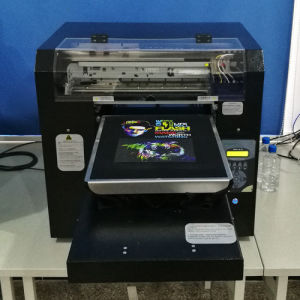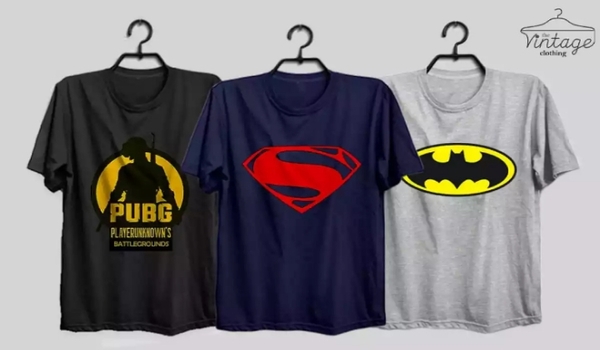Heat Press Vs DTG: Which one is best for your business?
As we discussed the six best methods of printing: Heat press, DTG, Screen printing, CAD, Vinyl printing, and Dye-sublimation. Heat press and DTG are two top options. In this article, we will compare heat press vs DTG in detail.
Direct to Garment Printing
Direct to Garment Printing, or DTG, is a printing process that prints onto fabric. The advantage of this process is that it can print onto any fabric and be used for various purposes.
DTG printers work just like your standard inkjet printer where you can use any paper on them – but instead of printing papers, it prints designs onto your shirt. This is similar to regular printers, so using and maintaining a DTG machine will be pretty easy if you are familiar with that concept!
It uses tiny little nozzles that pass over the fabric and apply the right amount of water-based ink to your apparel.
Heat press involves cutting, heat transfer, and printing.
Advantages of Direct to Garment Printing
- Direct to Garment Printing is a cost-effective process, making it easier to mass-produce
- Direct to Garment Printing is eco-friendly
- Direct to Garment Printing uses less energy, saving resources and being better for the environment.
- More colors are available when printing
- Direct to Garment Printing is suitable for large-scale printing, with more detail than screen printing.
Disadvantages of Direct to Garment Printing
- Cleaning a garment during printing is not always possible
- Requires water and detergent
- Lower Resolution
- Decreased product life
- Less fabric utilization
- More expensive
- More difficult to manufacture
- More challenging to find a market for the design
Do I need a heat press for DTG printing?
Heat presses are not required for direct-to-garment printing with DTG machines, but they will make the process easier.

Heat Press Printing
Heat Press Printing is a process of heat and pressure that can be used to print on various fabrics, paper, or other materials. It’s the best option for bulk and detailed designs when it comes to t-shirt printing.
Advantages of Heat Press Printing
- The ink stays where it is supposed to be.
- No ink drips from the press.
- The press is easy to clean and is not a messy operation.
- There is no need for a costly UV printer, as the process is a direct print.
- All parts of the design are at the same level, and the thickness of the paper is variable.
- All materials and fabric types can be used with this method of printing.
- Cost-effective
Disadvantages of Heat Press Printing
- The transfer of heat from the plate to the substrate can cause the substrate to warp or curl. You can use this heat and temperature chart.
- It can only print on certain types of material
- Printing is slow and takes time to complete
- Pressing force doesn’t last long

What is the difference between DTG and heat press?
The main difference between DTG and heat press is DTG is a Direct To Garment process that uses heat transfer printing to print on a garment while still on the press. In comparison, heat press is pressing fabric with a heated roller, then applying pressure with a heated iron to fix the design into the fabric.
Both DTG and heat press are perfect for textile printing. They both provide an easy way to print on T-shirts, but in reality, they have very different characteristics that should be considered if you want to use them properly.
Frequently Asked Questions
Which lasts longer heat press or DTG print?
Heat press lasts longer because it is transfer-based. Moreover, Transfers can be stored in a climate-controlled environment for years. This helps you when you need to print extras on demand.
Heat Press vs. DTG: What’s Best for Your Budget?
If you are on a budget, you may want to consider a cheaper alternative like direct-to-garment (DTG) printing. These prints are not as durable as other methods, but they are cheap and will last longer.
Related: Screen printing vs heat press
Which of the custom printing methods is the best choice for you?
The heat press is the best printing method. It allows you to print in bulk, and the prints are stunning and will last longer. This type of printing gives high-quality prints, which are best for a print shop.
Is DTG printing the right choice for your business?
It offers lots of possibilities that don’t exist with traditional procedures. DTG seems like an attractive option: fast turnarounds (as quick as 1-2 days), an endless choice of colors, and t-shirt styles (from organic cotton right through to fancy material such as velvet).
It means you can print exactly what your clients want without having to worry about minimum orders, lengthy lead times or minimum purchases.
However, if you expect a lot of orders, you should go for heat press printing. Here is a list of best heat presses for small businesses.
DTG printers will be great for smaller businesses as long as they don’t require more than 20 shirts printed per hour. While faster machines are on the market, they usually start at around $1,000, making them too expensive for most small business owners.
How much should I charge for DTG printed shirts?
This isn’t an easy question to answer, as it depends on the size of the shirt, the quantity, and the printing cost. However, we have an average cost for each shirt printed through DTG. You can charge at least $10. The price range can vary from $5 to $100.
Which is better vinyl or DTG?
Both are good, but DTG is more durable and ideal because it can be used on a broader range of materials.
How much are DTG printers?
The price for a good DTG printer is a little over $1000.
Which is the best DTG printer?
HRM A4 DTG T-Shirts Printer is the best DTG printer.
Heat press vs. DTG – Conclusion
DTG printers are an excellent option for businesses that need to print shirts or other garments quickly, but they’re not the most cost-effective solution. If you require more than 20 prints per hour and want something cheaper and durable, Heat Press is the best option.
Are you a beginner in heat press printing? Here is the Heat press beginners’ guide.
Best vinyl heat press machines
Best t-shirt printing machines
Additional Questions
Is a heat press business lucrative?
Indeed, running a heat press operation can be financially rewarding. This business revolves around utilizing heat press machines, which simultaneously apply pressure and heat for a predetermined amount of time, to effectively transfer a variety of compelling designs and visuals onto custom apparel. Therefore, there is plenty of room for creativity and customization. Given the popularity and demand for personalized clothing in the modern fashion market, successfully leveraging this opportunity could yield substantial profits.
Does a direct to garment business offer good returns?
Yes, direct-to-garment (DTG) businesses can be particularly lucrative due to their unique selling proposition. DTG operations are favored for their remarkably low setup costs when it comes to individual printing tasks. The ability to profit even from small batches or single items turns it into a profitable venture. Factor in the liberty of customization it affords- courtesy of standard graphic design programs to produce, modify images or text as per the customer’s requirements, it becomes evident how profitable this business can be. These elements offer a degree of flexibility and creativity that can strongly appeal to a diverse range of customers firsthand. Use this to your advantage and the financial returns can be significant.
What are the downsides of heat press printing?
While heat press printing does offer many advantages, there are also some cons to be noted. The heat press transfers a design via temperature and pressure applied to a substrate, such as cloth. While this technique can produce high-quality, durable images on a wide range of materials, it’s crucial to be aware that it’s not always suitable for all sorts of designs or fabrics. The heat and pressure applied by the heat press can easily damage delicate, heat-sensitive fabrics. Also, detailed or complex designs may not come out as clearly as desired due to the limitations of the heat press method compared to other forms of printing like screen printing. Additionally, these machines necessitate significant upfront investment and upkeep that might be prohibitive for some. A good understanding of these limitations would help you make a more informed decision about this venture.
Which is the superior approach, heat transfer, or digital printing?
Your decision between heat transfer and digital printing will depend on the specific look you’re aiming for. If you’re seeking a softer, vintage-style aesthetic, screen printing, which is a traditional and harder-to-master technique, may serve you well. But if you’re keen on leveraging the technological advancement to affix custom graphics to a variety of surfaces with precision, heat transfer could be your best bet. Meanwhile, for those looking for modern, crisp, and sharp visuals, digital printing can deliver wonderfully. This method can be a particularly smart choice for larger-scale orders that require a high level of detail and vibrancy. Ultimately, the choice between these methods also hinges on the business model, target audience, type of designs, and budget.

I’ve been in the printing business for 25 years. I love to share my experiences and knowledge.

